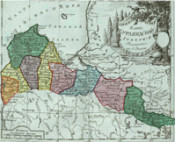
Issued Manifesto on annexation of Courland to the Russian Empire
The Duchy of Courland was formed in 1561 as the result of Livonian Order disintegration and the fact that a part of Livonian knighthood was now subdued to King Sigismund II August. On November 28 (December 11), 1561 was signed the agreement under which the Duchy of Courland became a vassal of the Grand Duchy of Lithuania. When the Polish-Lithuanian Commonwealth was formed in 1569 the Duchy of Courland became a vassal of Poland.
From the age of the Northern war (1700-1721) Courland was within the Russian sphere of influence. In 1710 the daughter of the Russian tsar Ioann V and the niece of Peter I Anna married Duke Frederick William of Ketler’s dynasty. After her husband’s death in 1711 she did not return to Russia in accordance with Peter’s will but stayed in Courland. In 1730 Anna Ioanovna mounted the Russian throne and her favorite Count Ernst Johann von Biron became the Duke of Courland in 1737. After the Empress’ death and Biron’s exile the Duchy of Courland had no Duke until 1758. The country had been ruled by the highest councilors.
In 1758 Courland was ceded to Carl of Saxony, the son of August III, who ruled it until 1763. After Biron’s return from exile he was again acknowledged the Duke of Courland and governed the country during seven more years.
In 1769 Biron passed the governance of Courland to his son Peter. However the discontented nobility opposed to him immediately and he managed to retain the power only with the support of the Russian Empress Catherine II. This was the time when the nobility of Courland was becoming more and more powerful. In the end of the 18th century the ideas of the Great French bourgeois revolution started to spread over Courland. Under the influence of these ideas the merchants, burghers and intelligentsia formed in 1790 the so-called burghers union which had as its object to reform the archaic system of the Duchy.
In the spring of 1794 several detachments struggling for liberation of Poland under the commandment of Tadeusz Kosciuszko entered Courland. At the requests of Duke and landowners the revolt was suppressed by the Russian troops commanded by A. V. Suvorov.
The nobility of Courland realized that the Duchy could not continue without a powerful government and in March 1795 resolved to renounce the feudal dependence of Courland from Poland and obey implicitly to the Russian Empire.
On April 15 (26), 1795 Catherine II issued the Manifesto ‘On annexation of Duchy of Courland and Semigallia as well as Piltene district for ever to the Russian Empire and on invitation of authorized representatives to the Senate for swearing the allegiance’.
The former Duchy of Courland and Piltene were united into a single province (Courland province) where the ‘Decree on provinces’ was introduced in full.
Lit.: Арбузов Л. А. Очерк истории Лифляндии, Эстляндии и Курляндии. СПб., 1912; Бантыш-Каменский Н. Н. Обзор внешних сношений России (по 1800 год). Ч. 3: Курляндия, Лифляндия, Эстляндия, Финляндия, Польша и Португалия. М., 1897; Бильбасов В. Присоединение Курляндии // Русская старина. 1895. Т. 83; Манифест благороднаго рыцарства и земства герцогств Курляндскаго и Семигальскаго, об отречении от существовавшей по ныне с Польшею связи = Дано в Митаве в земском собрании 18 марта 1795 года. Б. м., 1795; То же [Электронный ресурс]. URL: http://dlib.rsl.ru/viewer/01003334965#?page=1; Чешихин Е. В. Краткая история Прибалтийского края. Рига, 1894.
Based on the Presidential Library’s materials:
Полное собрание законов Российской империи, с 1649 года. Т. 23. № 17319. СПб., 1830. С. 664;

